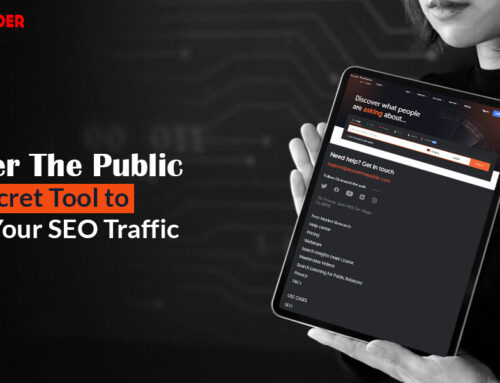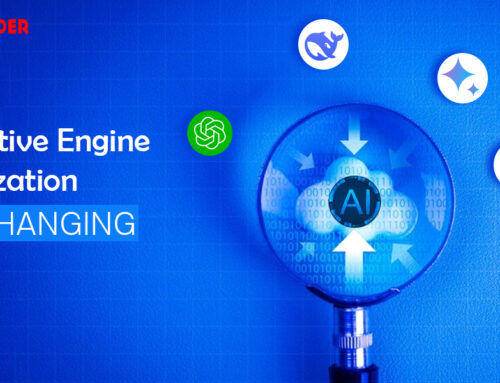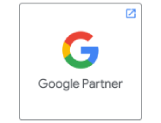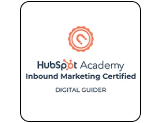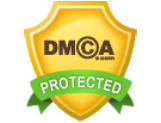Nothing compares to the feeling of successfully launch and promote a new website, right?
But it also comes with tons of headaches if you are not familiar with the experience beforehand. Even for the most seasoned digital marketers, building & launching a site can be quite stressful.
To help ease your nerves, we’ve prepared a comprehensive guide on how to launch a new website effectively to grow your online business presence, traffic, store visits, sales, & ultimately profit and revenue.
🖥️Launching a website is an essential business growth strategy. It not only opens the opportunity doors to reach your niche audience online, but it’s also a crucial touchpoint in the customer lifecycle for building trust and illustrating your unique value proposition (USP) in an easy way.
But if you want a smooth site launching, then you need to focus on the end goal questions in mind like— What do you want your website actually to do?
- Are you looking to set up a lead generator that works while you sleep?
- Do you want it to attract new readers to your ebook?
- Does it need to display your portfolio so higher-paying clients swing your way?
- Do you want your website to bring more profits & revenue?
- Or are you creating an e-commerce store to sell your products online?
If any of the questions above answer YES! Then this guide is only for you. Check this 11-step website launch checklist to ensure the site is ready to launch and effectively support visitors and your business when it goes live.
🚀Now, without further ado, let’s get started……
How to successfully launch and promote a new website in 10 steps

Step 1: Choose the Right Domain Name
The first & important thing about launching a new website is choosing the right domain name representing your brand. You’ll risk losing out on potential site traffic if the name is inappropriate & irrelevant.
When your target audience searches for your business online, you must appear at the top of the SERP rankings. To get a clear idea here’s a basic structure shown below; you need to know about the page’s URL.
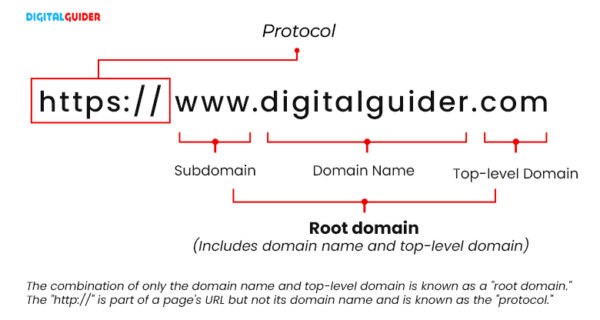
Website URL Structure
Now, how will it affect your website ranking?
Search engines will use the domain name of your business website as the primary signal that you are important & relevant to a user’s search term. There are (arguably) two kinds of domains:
- Branded domains
- Keyword domains
1- Branded Domain
A branded domain is when you have a business name that is a brand name. A brand name can communicate usefulness or an aspiration or subtly shares an affinity with the target audience through jargon or slang.
👉 Below, you can see the branded domain example that represents particular brands, i.e., DigitalGuider

Domain Name of Digital Guider
2- Keyword Domains
If you are not getting any idea, you can refer to keywords. Keyword domains can be powerful as visitors tend to want what’s in the keyword. As per the experiment, a two-word keyword domain can convert at a shockingly high rate.

Keyword Domain Example
👉 In the above example, www.VeganCakes.com is an exact match domain for the search term “vegan cakes.” In this way, you can search rich keywords & turn them into a domain. Make sure it is available.

Keyword Domain Example
How to choose the best domain name?
A good domain name should be short, memorable, and pronounceable if you squeeze in keywords – even better. Additionally, it would be best if you considered what your audience would be googling when searching for businesses like yours.
✅Here are 9 tips you must consider when choosing the right domain name
- Try to register a .com (it’s the most recognized)
- Use relevant keywords if you can (this helps with SEO and higher search engine rankings)
- Avoid hyphens
- Make it as short as you possibly can
- Keep it easy to pronounce and spell
- Keep it unique and brandable
- Don’t infringe on others’ trademarks
- Using your name
- Make sure the name is available
Successful domain names clearly tell their audience what content they can expect from that site. They have the added bonus of creating trust in visitors and helping the website rank higher in search results.
Keep reading this full guide on how to launch a website effectively as you’ll get to know the complete website launch checklist of every vital detail to grow your online business presence, traffic, store visits, sales, & ultimately profit and revenue.
To make it easier for you, select any of the below-mentioned domain name generator tools.
Top 15 domain name generators to help you pick the right business domain FAST
These domain name generators are AI-based, so they are not as perfect as we expect. However, it provides enough good ideas to get the creative & innovative juices flowing in your head so you can select the best domain name for your business website.
- Nameboy – Best Domain Name Generator
- Shopify Business Name Generator
- Domain.com
- Panabee
- Namecheap Business Name Generator
- Bust a Name
- Domain Puzzler
- NameStall
- WPBeginner – Business Name Generator
- Instant Domain Search
- IsItWP
- NameMesh
- Lean Domain Search
- Name Station
- Domain Wheel
- Nameming
- Bust a Name
- Domainr
🔴 Here’s an example of a Nameboy site where I’m looking for marketnorms.com, but as you can see, it isn’t available; also, you get various ideas regarding this domain.
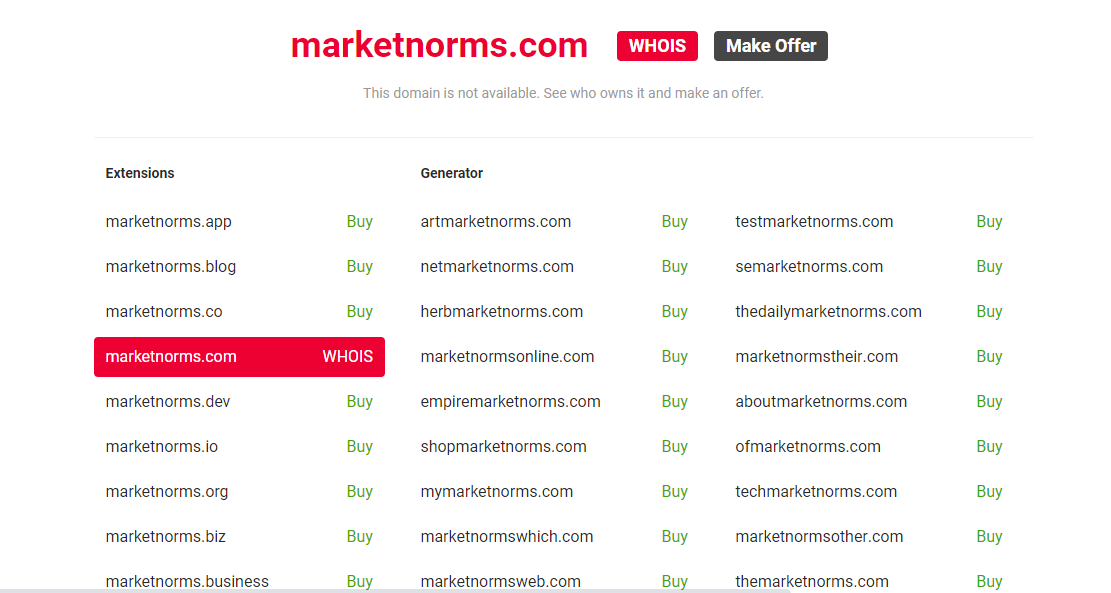
You can mix and match the words to create a unique & relevant domain name.
Step 2: Select The Right Web Hosting Provider
After selecting the appropriate domain, you need a proper place to live your website, which is web hosting. The second component of building & launching a website is finding the right web hosting services.
It might seem tough, but it isn’t.
Think of your website as a collection of files. Only you can open it when it’s “hosted” on your computer (like all of your other files).
Just like that, when you host web files on a web server, anyone can connect to that server through the internet. And find your business online. Hosting companies offer space on these servers for websites, so you don’t have to maintain your own servers.
Moreover, you can also select the same company from where you got the domain. It will help you do further tasks easily. Keep reading this guide on how to launch a website on google as you’ll get to know the complete website launch checklist of every critical detail.
Facing issues in registering your domain hosting? Our expert web-tech team is here to help you. Reach out to us now
Types of Hosting Services
🤔 Do you know? Online business solely relies on a user-friendly website.
For such comprehensive business visibility, proper web hosting is inevitable. Here are types of the leading web hosting services mentioned below:
- VPS Hosting
- Shared Hosting
- WordPress hosting
- Dedicated Server Hosting
- Cloud Hosting
You need to select an appropriate type of hosting as per your business requirements. Affordable price, Customer support, Storage, and performance are the key features. There are plenty of web hosting services here.
👉 While choosing your right hosting plan, cross-check all the below-mentioned features to avoid excessive investment in web hosting plans.
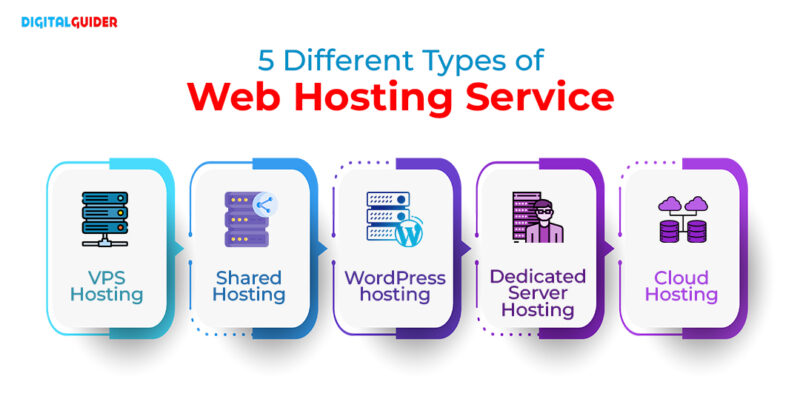
Types of Web Hosting Services
When evaluating different web host services, consider these 7 major hosting elements:
- Uptime: Refers to the time your website is guaranteed to be online. As with any technology, occasional problems can occur on your server. If your site is down, people can’t access it, which renders it useless. Most web hosts guarantee an uptime rate of 99.9%, meaning that 99.9% of the time, your website will be accessible.
- Data Storage: The amount of space that is available for your website files, images, videos, etc. Most hosting plans will offer unlimited data storage (or disc space), so this is not usually a concern for websites of the average size. You should look at the disc space more seriously for larger websites.
- Security: Most website hosting plans do not include a security monitoring service. If your website is built using an open-source CMS such as Shopify or WordPress and requires ongoing updates, you may be at risk for website hacks or malware injections. It’s a good idea to ask your host about additional security monitoring to prevent these vulnerabilities.
- Site speed is extremely important. People don’t stay on websites that take long to load, and Google ranks sites faster and higher.
- Bandwidth: The amount of data that the host can send from your website to your visitors on a monthly basis. Like data storage, it’s common for providers to offer unlimited bandwidth, but if your bandwidth is restricted, you may see additional charges if your limit is exceeded.
- Backups: Website backups are essential. Backups can be done manually, but we recommend setting up automatic backups with your host so that you always have a recent restore point.
- Customer service matters because websites have issues. Being able to reach out to web expert support and get your problem solved is hard to put a price on. All reputable web hosting providers will have these areas covered. Keep reading the guide on how to build a new website as you get to know everything regarding launching a new website.
Some popular web hosting providers:
- Bluehost (www.bluehost.com)
- HostGator (www.hostgator.com)
- GreenGeeks (www.greengeeks.com)
- Kinsta (kinsta.com)
- Namecheap (www.namecheap.com)
- SiteGround (www.siteground.com)
- WP Engine (wpengine.com)
- DreamHost (www.dreamhost.com)
- Cloudways (www.cloudways.com)
- Hostinger (www.hostinger.com)
- InMotion Hosting (www.inmotionhosting.com)
- Flywheel (getflywheel.com)
- A2 Hosting (www.a2hosting.com)
- IONOS (www.ionos.com)
Step 3: SSL Certificates
While selecting a domain hosting company, you need to figure out if they are providing an SSL certificate.
🔐 As it’s a matter of site SECURITY……
An SSL certificate is installed on the hosting server to provide a more secure connection between your website and its users. Websites with an SSL certificate are easily identified with the use of https:// instead of http:// in the URL.
SSL certificates are required. From July 2018, Google started displaying non-HTTP websites as ”not secure.” While Google has not yet confirmed its tactics, it has been suggested that websites without a valid SSL certificate may start to lose their positions in search rankings if they don’t comply.
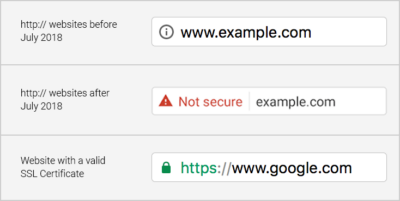
SSL URL Example
Step 4: Choose A Solid CMS
👍 Okay!!
Now you have selected the domain as well as the hosting provider.
🤔 But what next?
Now you need a software where you can design & create a website. That software is simply known as CMS.
A CMS or content management system is a software tool that allows you to design & create a website easily with a pre-created template, manage & optimize your content for SEO, and edit the content after it’s published.
Here are the core functions of the content management system that you need to know.
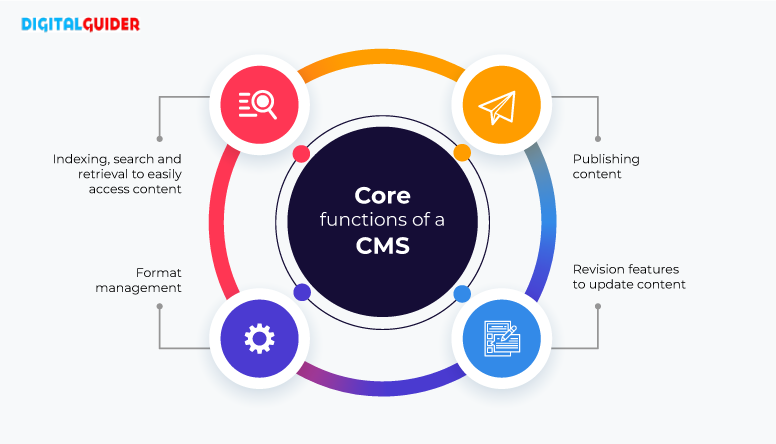
Core Functions of CMS-Info
This tool allows you to change and adapt the front-end appearance of your website, create pages, design portfolios, and add business blogs & articles. It also gives you the opportunity to manage videos, images, and other media. For example, Astra provides an extensive library of templates that you can easily customize without any coding.

Through CMS platforms, you can select the best theme and manage it through a manageable dashboard.
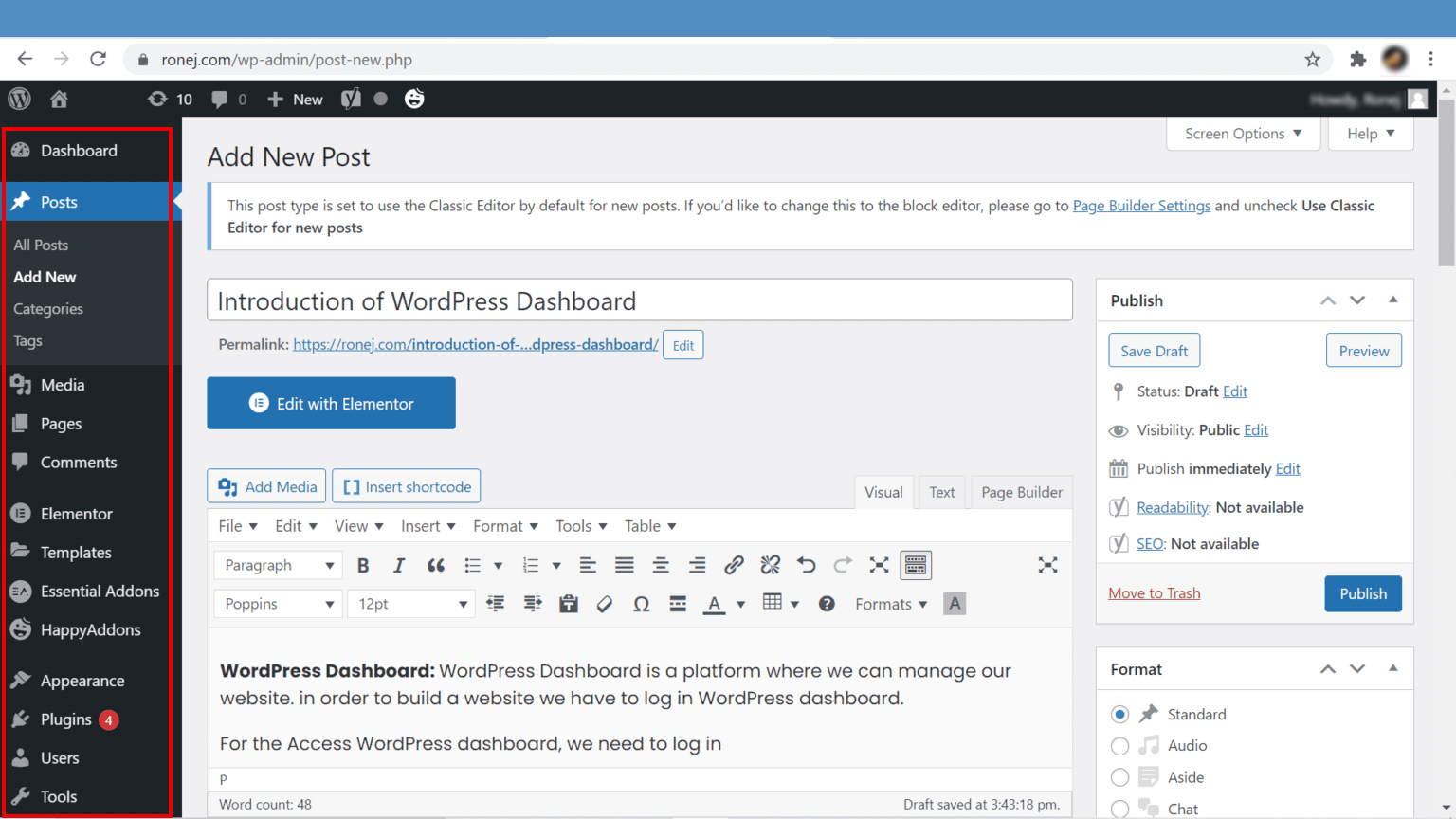
WordPress Dashboard
Some popular CMS platforms available:
Below are the most popular CMS platforms you can select from.
- WordPress
- Squarespace
- BigCommerce
- WooCommerce
- HubSpot CMS Hub
- Shopify
- Magento
- Wix
- Joomla
- TYPO3
- Drupal
- Textpattern
- Ghost
- Blogger
- PrestaShop
Step 5: Web Design that Leaves a Great First Impression
Now, it’s time to think about how your website will look. Design & site presentation are essential for first impressions.
The average visitor stays on a website for about 7 seconds, so you only have that short of a window to make a good first impression before they leave.
If you already have a logo, you know the exact colors you want to use for your website.
You should currently consider the styles you’ll use. To ensure a consistent user experience across your site’s pages, choose one design style and stick with it.
Now, you’re ready to roll up your sleeves and design your site, but how will you do it? Let’s understand this with the help of the example of the DigitalGuider site:
A) Provide proper white space:
Don’t flood pages with walls of irrelevant content. Allow your website “breathe” a little. Your site is there to share relevant information, but ensure that you present that information in the most user-friendly way.
Here in this DigitalGuider example, you can see there is enough white space to help readers or visitors understand the website layout & content easily without eyestrain👉👀.
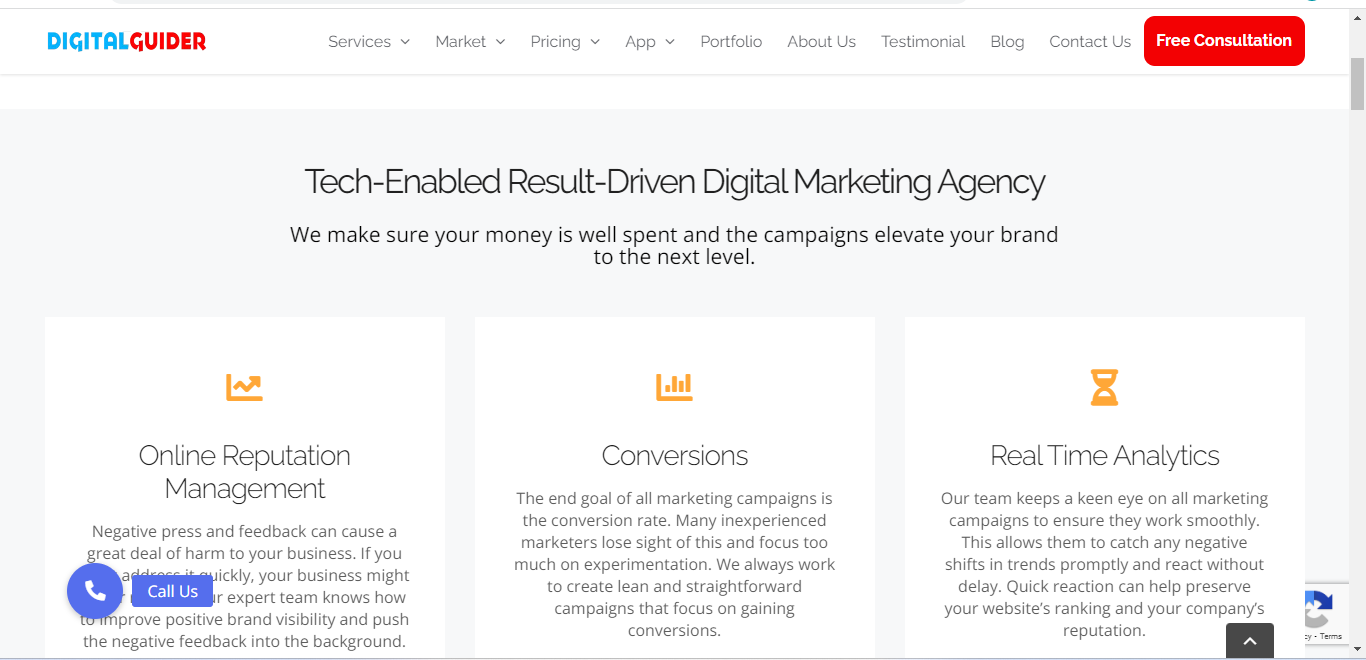
B) Simple site navigation is crucial:
Keep the number of menu options realistic; the fewer, the better. This is not to say that your website can’t have a lot of pages; rather, accessing a particular page shouldn’t be difficult.
Reduce the number of items in your menu and add links and buttons to individual pages to make it easier for users to navigate away from the menu and to other areas of your website.
🟢 In this Sephora example below, you can see the clear categorization like Makeup < Eye < Eyebrow

If you’re still facing issues, call our professional web developers now at +1-307-209-3608.
Step 6: Create Goal-Driven Content
You now have settled domain hosting and CMS and also have designed a magnificent website.
🤔 But I guess you have created a website with the demo content, i.e., (lorem ipsum)
Content is the soul of your website, as this element is the only thing that will attract, entice & convert your audience to your final customer.
Creating content pages requires a thoughtful approach to your purposes and goals. A content strategy works by building a journey from attracting the right audience to your website to converting them into customers.
❓Some questions you must ask yourself, like: What kind of content should you use to attract your target audience FAST?
Are you looking to explain more about your brand? Your services? Your expertise? Give every page you write one goal and let your content reflect that goal. When you find a focus for each page, stay on track by following these best practices:
1. Keep it Short and Simple
Don’t bore your readers or lose them in a seemingly never-ending flow of words. Plan out each page with a loose outline and bullet points. Great content keeps users interested and combines standard blog posts with images, videos, and audio or musical content. Provided simple & crisp content with a conversational touch on it.
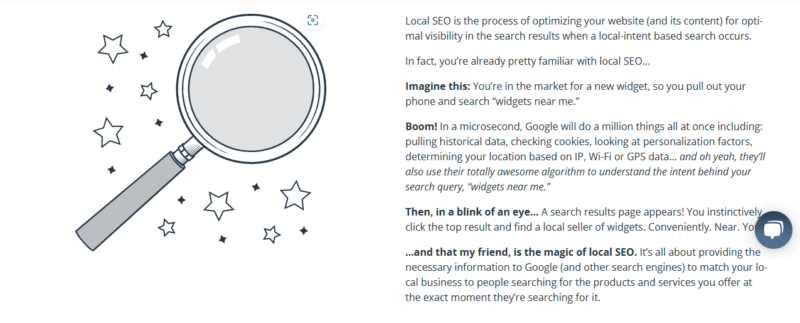
2. Your Content Should Not Be All About You
Please don’t babble on about how great you are. Your testimonials should do this heavy lifting for you.
Your content should strike a healthy balance between explaining how your brand will help visitors and giving your target audience what they’re looking for: a solution to their problems.
So even though this is your site, stop boasting about your achievements and focus more on serving your audience.
3. Brainstorm Your Calls to Action
Every piece of content you add to your site should be well thought out. But this is especially true for your calls to action.
If you want visitors to take action, you need to tell them to do so explicitly. That’s where well-crafted calls to action become the heroes of your website. When done right, they guide and motivate visitors to make a move.
In the same way, you have a goal for each page, your calls to action should also have a goal. What do you want your visitor to do? This same concept applies to your button text as well.
Some common examples of call-to-action buttons are:
- Add-To-Cart
- Free Trial Sign-Up
- Download Now
- Grab Your Copy
- Try It Now
- Get A Quote Now
- Get Started
- Sign Up
- Reserve Your Seat
- Learn More
- Swipe Up
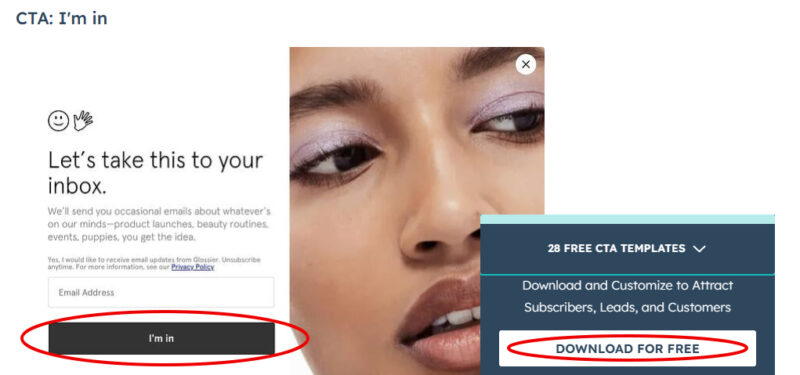
CTA Button Example
Step 7: Focus on Search Engine Optimization (SEO)
There’s no use in writing good content if your site isn’t ranking on SERP & your audience can’t find your site online.
You must ensure all your pages are fully optimized for search engine algorithms. SEO-friendly content enables you to rank higher in SERP listings, increasing your site’s visibility in the digital space.
Specifically, an SEO-optimized website has increased online visibility that drives new visitors to the website. New visitors mean new potential customers, so SEO has a great say in your sales numbers.
Consequently, since SEO can impact your site’s performance (and ultimately, your revenue), websites need a solid SEO strategy across:
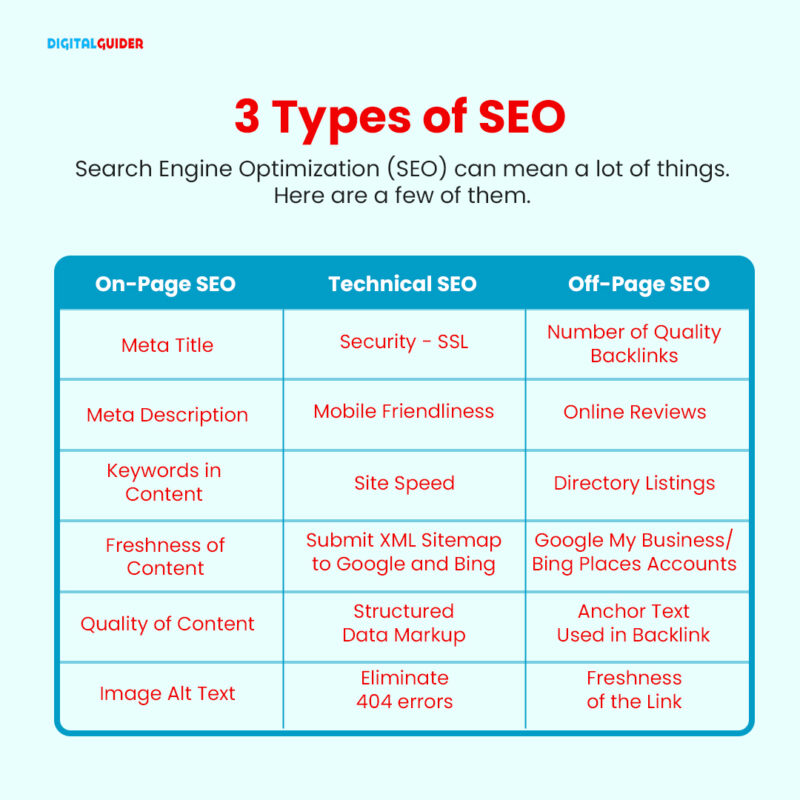
Types of SEO
On-Page SEO:
In this step, you need to give proper attention to these onsite elements which include: targeted rich keywords, Title tags, Internal links, Headings, Content (SEO copywriting), Meta descriptions, Relevant Images with alt text, & more optimizations.
Technical SEO:
This step includes technical approaches to meet search engine algorithms requirements. It refers to website & server optimizations that help Google spiders crawl & index a site more effectively.
Key things to check here are robots.txt files, loading speeds, site architecture, schema and structured data, canonical tags, XML sitemaps, mobile-first indexing, site security, and more.
Off-Page SEO:
This stage refers to actions taken outside of your business website to improve the site rankings. Most important off-site actions include backlinks creation, social media promotion, guest posting, PR, GMB optimization, etc.
Keep reading this comprehensive guide on how to launch a new website effectively as you’ll get to know the complete website checklist of every crucial detail to grow your online business presence, traffic, store visits, sales, & ultimately profit and revenue.
Step 8: Strategize Your Conversion Paths
What’s your ultimate goal? 💵Sales–🤑Revenue–💰Profits…..Right?
For that, you must build a conversion strategy that will direct your audience to take relevant action through CTA.
You must decide precisely what actions you want users to take and how you’ll collect their information. This includes considering
- What premium top-of-the-funnel offers are needed
- What forms need to be created
- What bottom-of-the-funnel action will be shown on the main page
- How will you track the conversions
- What type of actions will happen after a website visitor converts (email subscribers or responders, etc.)
- What landing pages and thank you pages need to be created
Step 9: Set Up Analytics Tools
Every brand should know how visitors engage with their content and how the site functions. This is why analytics platforms like Google Analytics and CMS analytics must be monitored.
Here are the major 14 tracking and analyzing KPIs that will give you valuable insights:
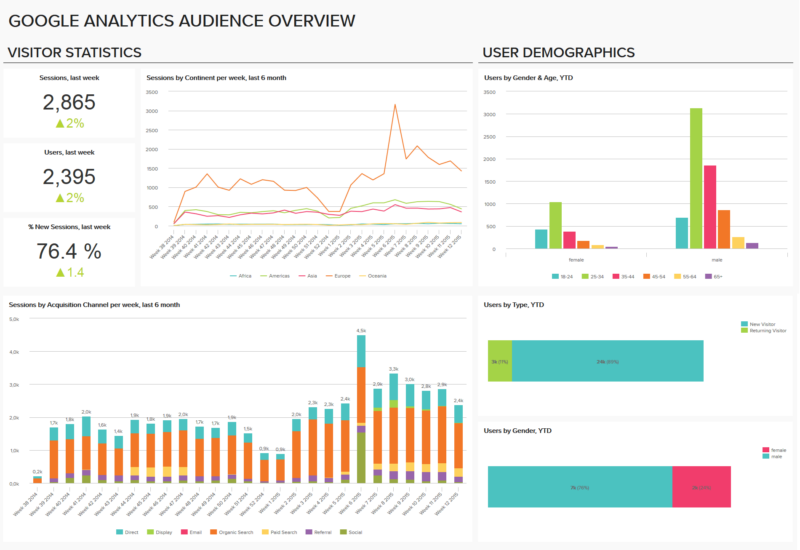 Google Analytics Audience Overview |
So, it’s important to figure out which metrics you want to keep track of before launching your website & how they are performing to give you more quality traffic, sales & profit. Keep reading this comprehensive guide on how to launch a website effectively as you’ll get to know the complete website checklist of every crucial detail to grow your online business sales, profit, and revenue.
Step 10: Website Launch Announcement— Do This As Part Of Your Launch
There are numerous ways to announce your new website launch. It totally depends on your business and its customers and how you choose to market your website. Some options for announcing your new website include:
- Social media: Social media posting is a cost-free way to promote your new website. With a strong marketing strategy, you can use social media to drive targeted customers to your website.
- Email marketing strategy: If you have a list of email subscribers, you can use it to inform them of the launch of your new website and explain what has changed and how it might affect their interactions with your brand.
- Press release: You can use a press release to inform the media about your new website if it can help your customers or provides something special that no other company does.
- Promoting offers: Giving visitors something in return is the best way to increase the number of visitors to your new website. An offer can be promoted via email or social media to increase website traffic and boost conversion rates. Keep reading this comprehensive guide on how to launch a new website effectively as you get to know the complete website checklist of every crucial detail to grow your online business presence, traffic, store visits, sales, profit, and revenue.
How much does it cost to launch a website?
The cost of launching a new website varies depending on your business, your budget, and the method you use to create your website. You can save thousands of dollars if you design and build your own website.
👉 But no doubt, it takes a lot of effort & valuable time to plan, build, optimize, promote & more steps. DigitalGuider, an affordable digital marketing agency in the USA, can help you grow your business, organic traffic, sales & revenue. A few upfront costs are associated with building, maintaining & launching a website, including domains, hosting, and SSL certificates.
If you want personalized digital marketing services for your business and want to skyrocket your traffic, sales & revenue, then we have got a customizable package for your every business need. You can add, delete, or modify your package as per your requirements. We are a one-stop solution for your business growth.
Our best services include customized web design & development and effective SEO to boost traffic & revenue. Our digital marketing experts team will guide you throughout the process & choose the best custom package that best suits your business.
You just have to focus on your business & we take whole online growth responsibility. Book your free consultation call now at +1-307-209-3608 & tell us your business requirements today.
The Key Takeaway
🖥️ When it comes to launching a new website, keeping all of the above-mentioned steps in mind & optimizing your website for them will help you drive early success with high ROI & revenue. Long-term success comes with an effective long-term strategy, so getting support from experts is crucial to create the best user experience & level up your brand to the next level.🚀
Need more tips & information for your business ranking, branding, and marketing? Visit our blog section now. There you’ll find a lot of useful tried & tested advice and insights into different areas of the online world – from SEO to e-commerce to web design & more.
📚Happy Learning!

